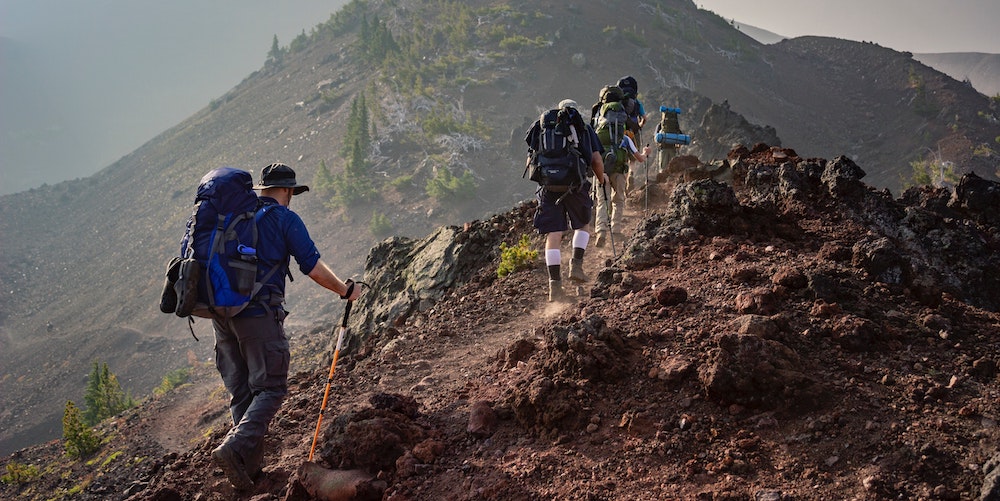
In this article, we are going to dive into the top 6 causes of sore knees after hiking to help you try and identify what might be causing your pain. It is worth noting that you will most likely have a primary contributing factor but can also have a second and third. We will focus on:
- Terrain & Gradient
- Muscle weakness and imbalance
- Overuse
- Walking Gait
- Footwear and mechanics
- Recovery and preparation.
When you walk or run downhill your knees can take up to 8 times your body weight through them compared to 3.8 times on the flat. This is also amplified due to the fact your muscles are often fatigued following the incline portion of the trail. So what happens to your knee as you walk on the decline?
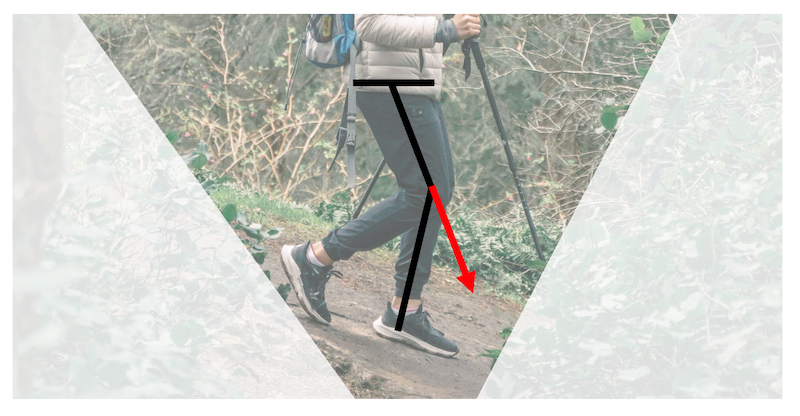
In this image, the black lines represent the supporting structures of the pelvis, thigh and lower leg, and the red arrow indicates the direction of force as you travel downhill. When you travel on a declining gradient your centre of mass and distribution of weight changes slightly from being directly below you to being slightly in front of you. What this does is changes how the load through your knees.
As it has transferred forward it can create a "sheering" movement in the knee where the thigh bone wants to slide forward and the lower leg bones (specifically the tibia) want to remain planted.
Pain & Symptoms.
This will often present itself as a pain in the front of the knee just below the kneecap. It will start as a dull ache but progressively get worse until it feels quite sharp. Another name for this is patellofemoral pain syndrome.
What to do
On the walk, try following a zig-zag line down the slope instead of a straight line. This will reduce the stress through the knee by altering your weight distribution. This is a short-term measure and what you really need to do is work on the quads, glute and hamstring strength. There are some good exercises in this article that teaches runners how to build up the same muscle groups.
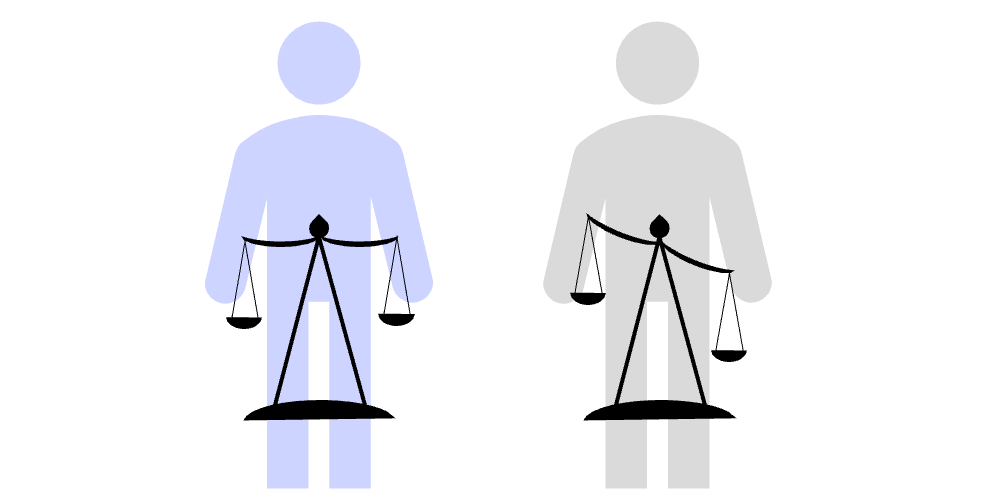
Although they are different contributing factors for sore knees after hiking they two are very much integrated into one another. Muscle weakness typically occurs following extended periods of rest such as recovering from an injury and the imbalance occurs when the injury is to one specific side. An easy example is to use someone who has had one leg in a cast for 4-6 months. When the cast is removed that leg has often experienced muscle wastage but the other side remains strong as it has been used whilst on crutches.
Another factor behind a muscle imbalance is your gait pattern when hiking, especially when you are fatigued. When all muscle groups are functioning at full capacity everything is balanced like the image on the left. But if one muscle or muscle group is weaker and fatigues quickly the opposing group will "pick up the slack" and over time become stronger with the others becoming weaker.
A muscle strength imbalance can cause sore knees after hiking because it will change your mechanics and the direction of the force through the knees.

Walking poles can help to reduce sore knees after hiking. By shifting the weight onto the poles through your arms, they add stability and help lessen the strain on your knee and leg joints. Knee discomfort can be decreased and strength and endurance can be increased when climbing hills by using walking poles, even just one.
Check out Hiking Poles
Doing too much or too frequently can overstress the knees and joints, causing pain and inflammation. As hiking is typically a hobby that is undertaken at the weekends it is easy to overdo things. The repetitive motion of the knees during hiking might overwork the muscles and tendons especially if there is undulating ground underfoot or varying levels of terrain gradient. When getting into hiking for the first time or after returning from a period of rest you shouldn't push yourself too hard because this can overwork your muscles. Hiking distance and intensity should be progressively increased to allow the body to adjust to the new level of exertion.
Actions: Review your hiking schedule and try to supplement it with some gym-based exercise to strengthen your leg muscles. Equally, it is important to implement a recovery plan to help your body recover, you can read more about this further down the page or by checking out the Golden Hour of recovery.
Flat
On level ground, you should move at a calm, steady pace. Step more slowly and land your feet heel to toe. Engage your core for stability and to safeguard your lower back while maintaining a straight back and relaxed shoulders. Moreover, you should strive to avoid locking your knees and maintain a balanced weight distribution over your feet. Last but not least, manage your pace and balance by using your arms.
Incline
The gait should be shorter and more controlled when going uphill. Use your calves and glutes to move yourself forward while taking smaller, more frequent steps and landing heel-to-toe. Keep your shoulders relaxed, chest high, and back straight. For stability and to safeguard your lower back, you should also concentrate on activating your core. Finally, try not to lock your knees and remember to slightly bend them with each stride.
Decline
Use a long, controlled stride when trekking downhill. Land heel-to-toe, with your knees slightly bent and your torso tilting forward. Take longer strides. To maintain stability and safeguard your lower back, be sure to maintain a tight core and a straight back. Also, make an effort to maintain a neutral spine, relaxed shoulders, and arms. Finally, manage your pace and balance by using your arms. You can also walk in a zig-zag to avoid additional stress on the knees.
Wearing old or using improper walking shoes can cause sore knees after hiking. Walking shoes are primarily designed to support and cushion the feet and legs, especially the knees as well as provide additional grip to avoid slips and falls. Hiking shoes that are not particularly made for the runner's foot type and gait pattern can cause weariness and soreness in the feet, legs, and knees. Second, the cushioning that aids in absorbing the stress of hiking can be greatly reduced over time when walking shoes deteriorate. This implies that walking without enough cushioning will cause the knees to absorb a greater portion of the impact, which might cause knee pain.
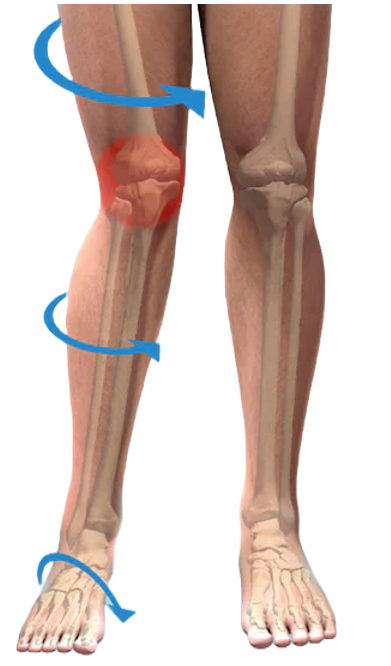
The incorrect or old footwear can lead to an imbalance in how the feet strike the ground when hiking, which can lead to the knees being out of place and hurting. For instance, wearing the incorrect shoes can cause a hiker with a flat foot to have their feet roll inward excessively, which can result in sore knees. Last but not least, wearing hiking shoes that are too small or big can let the feet slide around, which can result in knee pain and another imbalance in how the feet land on the ground. In order to avoid sore knees after hiking, it is crucial for you to invest in the right running shoes or orthotics to correct your foot mechanics.
Orthotics
You can buy over-the-counter orthotics that can be placed inside walking shoes to provide additional cushioning and support. To check out recommended orthotics please follow the link below.
Every physical exercise must allow for recovery time since it enables the body to regenerate and heal torn muscles, tendons, and ligaments. This is crucial during hiking because the repeated impact can harm the knees, hips, and ankles. Insufficient recovery time gives the body inadequate time to restore itself, resulting in soreness and pain. Knee pain after hiking might also be caused by inadequate healing regimens.
insufficient recovery time and poor recovery protocols are two of the main causes of sore knees after hiking. To ensure proper recovery, it is important to include adequate rest, proper nutrition and hydration, and proper form while running.
Applying heat before you go out walking is an excellent way to reduce sore knees after running by warming up the structures of the knee. Heat can be applied with the Riixo Knee cuff or by using a hot water bottle. This will stimulate blood flow into the area ensuring that there is enough oxygen and nutrients to the muscles as well as improving the elasticity of the muscles and tendons.
Actions: Start to implement a recovery protocol to your training to make sure that your body is able to repair itself ready for the next session. Read The Golden Hour of Recovery to learn about some simple steps you can take to improve your recovery protocols.
Ice, Heat and compression in one award-winning product
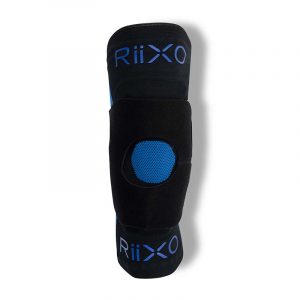
 British Triathlon: Recovery Questions Answered
British Triathlon: Recovery Questions Answered
 Cracking The Injury Risk Equation
Cracking The Injury Risk Equation
 LJMU Study Findings
LJMU Study Findings
 What are shin splints?
What are shin splints?
 How to treat shin splints [2021]
How to treat shin splints [2021]
No Thanks – I’ll pay full price
Close Window
Close Window